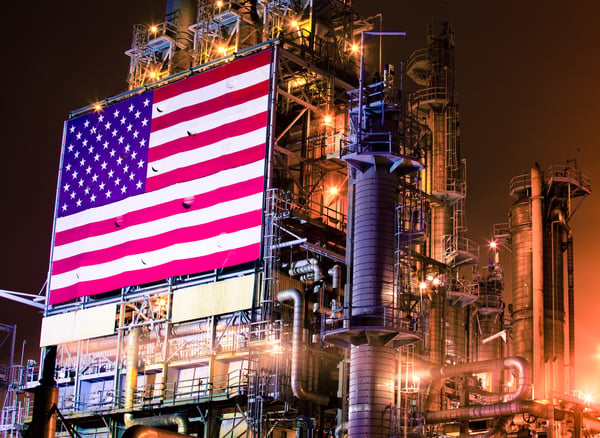Blog Post
Crude Oil, Refined
Jun. 24, 2020

We all have a vague sense of oil: it comes from the ground, is changed into a useful fuel source or petrochemical, and eventually benefits our lives. Oil headlines regularly splash across the news, and we notice when gas prices fluctuate.
But what does the average American actually know about the refining process itself? In truth, we probably know more about cooking oils than we do about crude ones.

Oil refinery plant in Southern California with an American flag displayed. What is Crude Oil?
Crude oil is an unprocessed, unrefined, natural liquid found deep under the Earth’s surface. Although often called “black gold,” crude oil is found in a range of different colors, from clear to yellow to deep black. Its viscosity changes, too, varying from a watery liquid to almost solid.
As a type of fossil fuel, crude oil comes from fossilized organic matter, plants and animals that lived millions of years ago. Because it takes such a long time to form, crude oil is a non-renewable source of energy—i.e., we will use it up long before more can be created.
Fuels like gasoline, jet fuel, kerosene, and diesel are made from crude oil, along with petrochemicals and other essential products.
Refining Crude OilChemically speaking, crude oil is made up of seven materials: carbon, hydrogen, sulfur, nitrogen, oxygen, metals, and salts. However, the real stars of the show are the hydrocarbons.
Hydrocarbons—any compound made from a combination of hydrogen and carbon—are full of energy. They can take on many different shapes and forms, depending on how many carbons and hydrogens are linked together, and in what way. Methane (CH4), ethane (C2H6), propane (C3H6), and butane (C4H10) are all hydrocarbons referred to as NGLs (natural gas liquids) and are used for different purposes—you wouldn’t heat your grill with ethane.
In crude oil, hundreds of these different kinds of hydrocarbons are jumbled together in one messy, problematic liquid. In order to be useful, the different types of hydrocarbons need to be separated. Or, to put it in layman’s terms, the oil needs to be refined.
Refining the oil can be done in a few different ways, but the most traditional way to separate the hydrocarbons is to distill the crude oil. Essentially, the oil is boiled, forming gases, which are collected as separated hydrocarbons and made into useful products.
Oil TerminologyBecause crude oil comes in different colors, textures, and density, it’s sorted into four categories. These types of oil are based on three things: viscosity, volatility, and toxicity.
Viscosity refers to how the oil flows. The higher an oil’s viscosity, the less easily it flows. If maple syrup were an oil, it would have high viscosity, while iced tea would have low viscosity.
When an oil is highly volatile, it means it evaporates easily. Volatile oils require more care when being extracted from the ground to prevent it from evaporating into the air.
Toxicity is straightforward: it describes how toxic the oil is. If it spills, how much harm would it cause to humans and the environment?
Using these three descriptions, crude oil can be sorted into categories.
Types of Crude OilCrude oil is categorized into four main types:
-
Very Light Oils
- Light Oils
- Medium Oils
- Heavy Fuel Oils
Where Crude Oil Comes From
Oil is found all over the world, but there are a few areas that are especially oil rich, such as the North Sea in Europe, the OPEC countries, Oman, and the U.S. states of Texas, Louisiana, and North Dakota. Geographical locations are often used to descriptively classify crude oil, since the geographical location changes the properties of the oil. Two well-known oil classifications are Brent Crude and West Texas Intermediate (WTI), whose oil prices serve as a benchmark for comparing the price of oil around the world.
Brent Crude comes from—and supplies—Europe. It’s a blend of oil that is extracted from 15 oil fields in Scotland, Norway, and the North Sea. Because of its low density and sulfur content, it’s described as “light” and “sweet.”
West Texas Intermediate comes from—you guessed it—Texas! It’s even “lighter” and “sweeter” than Brent Crude and is an ideal oil to be made into gasoline. Fortunately for America, gasoline is one of our most-used fuels.
Dubai and Oman Crude—sometimes called Fateh—is a medium oil. It is one of a few oils available in the Persian Gulf, and serves as a price benchmark, as do Brent Crude and WTI.
The OPEC Reference Basket refers to the OPEC—Organization of Petroleum Exporting Countries. There are currently 14 members of OPEC: Algeria, Angola, Ecuador, Equatorial Guinea, Gabon, Iran, Iraq, Kuwait, Libya, Nigeria, Republic of the Congo, Saudi Arabia, United Arab Emirates, and Venezuela. *
The OPEC Basket is a mix of light and heavy crude oil, but all of it is heavier than Brent or WTI crude. Weighing the average prices of all OPEC members, the OPEC basket is the fourth important benchmark for crude oil prices.
Combined, Brent, WTI, Dubai and Oman, and the OPEC Basket control the majority of the world’s oil and market prices.
What Happens Next?Once the crude oil is harvested from the ground, it is transported to refineries, where it can be distilled into useful products and distributed to consumers.
As for Dixon, we manufacture and supply a wide range of fluid transfer solutions for the oil and gas industry. We’re here to solve industry challenges, offering the right connection every time.
Please  to see how Dixon can help with your company’s oil and gas needs.
to see how Dixon can help with your company’s oil and gas needs.
*Ecuador left OPEC on January 1, 2020
Sources:
- https://www.investopedia.com/terms/c/crude-oil.asp
- https://www.plainsmanmfg.com/blog/four-main-types-crude-oil/
- https://oilprice.com/Energy/Crude-Oil/A-Detailed-Guide-On-The-Many-Different-Types-Of-Crude-Oil.html
- https://www.nationalgeographic.org/encyclopedia/petroleum/
- https://en.wikipedia.org/wiki/Brent_Crude
- https://en.wikipedia.org/wiki/West_Texas_Intermediate
- https://en.wikipedia.org/wiki/Dubai_Crude